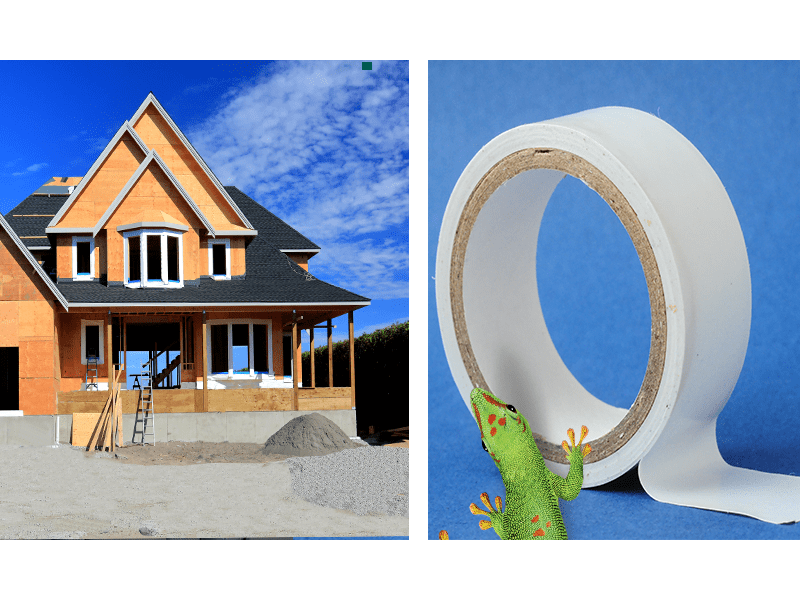Mar 15, 2021 - 10 min
How Seam Sealing Tape Makes It Easy to Address Building Industry Trends

Construction manufacturers, builders and contractors are concerned with constructing safe and energy-efficient buildings that protect occupants from outdoor elements. One key way to do this is by creating a proper building envelope for environmental separation.However, separations between air and vapor barriers and the building envelope can disrupt the barrier’s ability to keep unwanted heat or elements out of the structure. An easy way to address this issue is with high-performance seam sealing tape. Seam sealing tape not only addresses the need for continuation of barrier materials, but it can also address key market trends.Learn three ways seam sealing tape can make it easy to meet trends in the building industry.
What is Seam Sealing Tape?
Seam sealing tape is used during construction to seal cracks or gaps that could allow air or moisture to enter the building envelope. It is often applied around the edges of an air or vapor barrier to ensure environmental elements are completely sealed out of the building. It may also be applied around door frames, windows or corners to provide additional protection from air and moisture.
How Can Seam Sealing Tape Meet Key Trends?
Stringent Building Codes
In the last decade, government regulations have implemented strict standards against air leakage.These regulations require that new and existing buildings have strong air and vapor barrier systems to help prevent structural failures caused by air leakage.
Due to these increased standards, achieving a successful building envelope and airtightness has become more difficult.In older buildings, an air or vapor barrier that was once effective may have lost its strength over time, requiring new barriers to be added. This means builders will need to start new projects for existing buildings that may be complex and time consuming, especially if the building has outdated or faulty construction materials. Additionally, these regulations may limit the design aspects architects can achieve in new buildings. This is because gaps in insulation or barriers often found near windows, doors or corners may cause air leakage.
Fortunately, seam sealing tape possesses attributes that can address these challenges.The tape is easy to apply, helping to reduce installation time during the construction of a new building envelope or implementing a barrier in an existing building. Seam sealing tape can also be used to fill gaps in common areas where air may enter the structure, including windows, doors, corners and flooring. This widens the architect’s design capabilities by providing continued tightness through the entire building while meeting regulations.
Energy Efficiency
As more homeowners and builders become interested in sustainability initiatives, energy efficiency has become a crucial aspect of the building envelope. Energy efficient buildings can help cut carbon emissions, reducing air and water pollution. Beyond sustainability, energy efficiency also improves the safety of a building, improving ventilation, weatherproofing and heating and cooling costs. Air and vapor barriers are a key aspect of increasing the energy efficiency in homes and buildings. They can help keep homes comfortable in various climates and protect moisture or other unwanted particles from entering the structure.
For air and vapor barriers to be effective, they must have a proper seal. This can be challenging because if there are gaps in the seal, air and moisture can leak in, creating draftiness and leading to increased energy use.
Seam sealing tape can help maintain energy efficiency by providing consistent, continuous sealing over the edge of a barrier. This ensures that no areas of the seal will be weakened by inconsistent application, and it seals out unwanted air and moisture effectively.
Building Longevity
When constructing homes or buildings, consumers desire a place that will stand the test of time. Air and vapor barriers can improve the longevity of a structure by keeping out moisture or air particles that could cause mold or other issues.
However, a barrier is only as effective as its seal. Depending on the material used, the seal can degrade over time after being exposed to moisture and seasonal temperatures for prolonged periods. This can cause weak points in the seal, impacting the barrier’s ability to effectively trap out unwanted particles and leading to structural issues.
Fortunately, seam sealing tape can maintain performance over time, which helps improve the building’s longevity. Its consistent application ensures there are no weak points in the seal, prolonging the seal’s lifespan. Further, adhesive technologies ideal for seam sealing tape have advanced to make tape solutions that can last 20 or more years. This ensures the air and vapor barriers will be safe from wear and tear, improving the structure’s longevity.
Seam sealing tape can improve your air and vapor barrier applications overall and help you meet key consumer trends. If you’d like to learn more about how seam sealing tape can help your construction processes, talk to your tape supplier, or contact a Bostik representative today.
